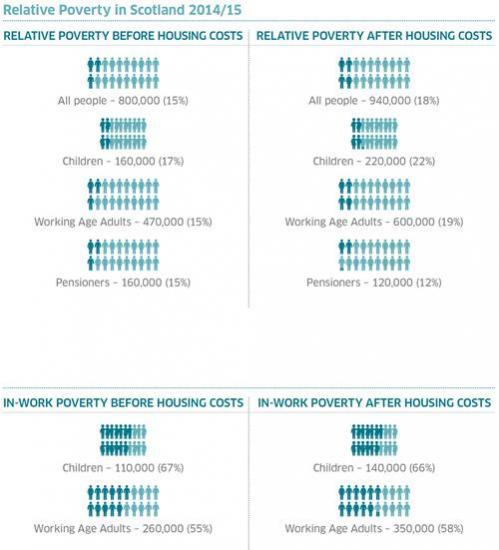Statistics on poverty in Scotland in 2014/15 show a complex picture
3rd July 2016

Relative poverty before housing costs (BHC) increased in 2014/15. While incomes for poorer households increased in 2014/15, middle income households saw a greater increase.
In 2014/15, 800,000 people (15%) in Scotland were living in relative poverty, BHC. This was an increase from 730,000 (14%) the previous year.
However, there were also real terms decreases in housing costs for those on a low income, which led to after housing costs (AHC) poverty remaining unchanged.
In 2014/15, 940,000 people (18%) were living in relative poverty, AHC. This was the same as the previous year.
Absolute poverty considers whether living standards for those on low incomes are keeping pace with inflation. In 2014/15, incomes were higher, inflation was low, and housing costs were lower than the previous year. This meant that absolute poverty remained unchanged BHC, while there were fewer households in absolute poverty AHC.
Child material deprivation decreased in 2014/15. Moves into employment, especially for those in lower income households, led to increases in household income. This, combined with low inflation, meant fewer children lacking the basic necessities.
There was also a decrease in the number of children living in workless households in 2014/15. However, the move was largely into part-time employment, especially for lone parents. For working families who also receive benefit income, especially families with children, increases in earnings were balanced against reductions in benefit income, combined with a one per cent cap on benefit up-rating. People not in employment and reliant on benefit income saw the smallest increase in income in 2014/15.
The proportion of people in poverty in working households increased in the latest year. Two thirds of children in poverty lived in working households in 2014/15. The move into employment was largely into part-time work, especially for women, meaning that while people were in employment, they remained in poverty.
In 2014/15, income inequality increased. The top ten per cent of households saw the largest increases in income while the bottom ten per cent saw no real change. This has stretched the income distribution, resulting in low income households falling behind those in the middle and even further behind those at the top.
